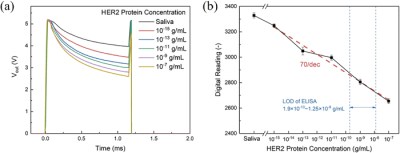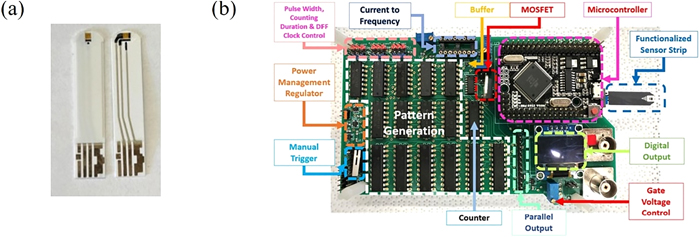More and more biomarkers that can help in the early diagnosis of diseases like cancer are being discovered every year, but often the effective application relies on having diagnostic methods that are both affordable and as least invasive as possible. This is definitely true in the case of breast cancers, where the standard diagnostic method after seeing something ‘odd’ on a scan is to perform a biopsy so that a tissue sample can be tested in a laboratory. What [Hsiao-Hsuan Wan] and colleagues demonstrate in a recently published research article in the Journal of Vacuum Science & Technology B is a way to use saliva on disposable test strips to detect the presence of cancer-related biomarkers. Best of all, the system could be very affordable.
The two biomarkers tested in this experiment are HER2 (in 10 – 30% of breast cancer cases) and CA 15-3, both of which are indicative of a variety of cancers, including breast cancers. According to the researchers, the levels of these biomarkers in saliva can be correlated to those in blood serum. Where other biosensors may include the read-out circuitry – making those disposable and expensive – here the disposable part is the test strips which are plated with electrodes.

Each test strip is processed by exposing it to monoclonal antibodies for the target biomarker. When the resulting strip is then exposed to a series of pulses, any antigen-antibody complexes will stretch and contract, causing a measurable change in the electrical signal. This signal is then amplified by a MOSFET, after which the data can be analyzed. According to the reported results, the experimental results matched with the (anonymized) samples from both healthy volunteers and patients with breast cancer.
Whether a saliva-based test like this will replace most biopsies remains to be seen, but if the saliva-blood serum correlation holds up in further testing, it might provide a quick and non-invasive way to test for these and other biomarkers, whether for cancer or other diseases.

















Weird picture of the PCB. Many through hole components and the remarks don’t make sense. Did they just take a random PCB as picture and slap some random texts on it?
You can’t expect PhD candidates to actually put in proper work for all the papers they produce! You’re not meant to take anything but the text seriously /s
Just a while ago someone tried to get a paper with AI generated image (complete with garbled text) of a rat with massive testicles peer reviewed. And guess what? No one had a problem, it achieved peer review status without a problem
Link: https://www.frontiersin.org/articles/10.3389/fcell.2023.1339390/full
Academia. Never fails to disappoint.
I don’t know anything about the journal publishing it, but holy hell if the figures I’m seeing are the ones used in the original paper before its retraction, that should be the end of it.
The only thing really odd is the “pattern generator” section.
Assuming the paper is legit (a big assumption) I’d say it’s most likely they refused hardware they had sitting around the lab from some previous thing. When I was a grad student it wasn’t unusual at all to have 20-year old hardware sitting disused in a corner. If you’re a grad student who knows something about protein sensing and nothing about hardware, your advisor might point you to that board in the corner and say “why don’t you see if you can make that work”. Doesn’t matter if it was designed to do 14 things you’re not using, if you can correct it to do the one thing you need for your paper, you’re off to the races. Even better if you can just reuse the diagram from the previous student’s paper which described the hardware, since you never managed to understand half of it….
10-30% success is not a leap forward or a potential replacement for a biopsy.
More importantly, what is the false positive rate?
That’s a weird PCB! – I found a better image of it online: https://publishing.aip.org/wp-content/uploads/2022/12/JVB22-AR-GM2023-00222_fig1.png
Do you have the context for the photo? I can’t make out what the text on the DIP components are, but the third one is half out of the socket.
Found it! Your photo is actually a different but almost identical looking board, for another earlier article which shares a number of authors: https://publishing.aip.org/publications/latest-content/point-of-care-biosensor-rapidly-detects-oral-cancer/ and the older article is https://doi.org/10.1116/6.0002175
You can see that the oled screen on the bottom right has a different board color and that the chips in the newer article appear to be soldered to it.
I call BS
It seems like every other development in medicine is low cost, up until they hit the patent office.
This accurately detects something that 10% of breast cancer patients have. So what exactly is the market use case. Take this test if it comes up positive you probably have cancer if it comes up negative that means nothing. Unless the test is <$5 after research and manufacturing costs I can't see many people paying for it.
Dear HaD. Stop publishing this garbage. Press releases from sad journals or researchers are not news.